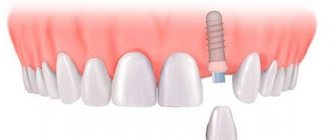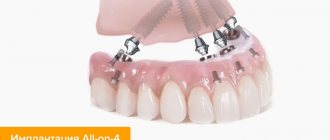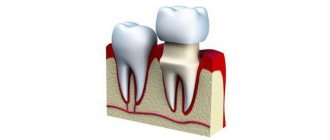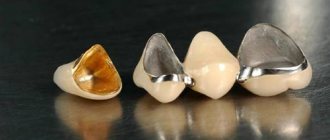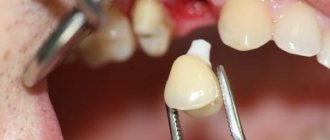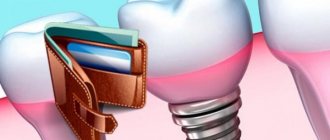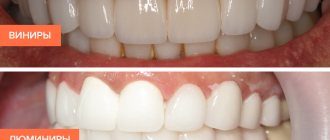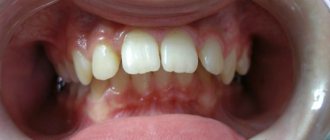The word “dentistry” in an ordinary person only evokes attacks of fear and lack of desire to see a doctor. New technologies in dentistry make it possible to get rid of this phobia, because they are aimed at improving the quality of the dentition and reducing pain during treatment.
There are many dental methods for restoring not only aesthetic, but also functional qualities to the dentition. The result of the work will be so good that an experienced dentist may not immediately discern the work of the previous master.
Implant systems
Implant systems are the best radical treatment method in dentistry. This technology allows for the highest quality replacement.
The essence of the technique is to implant a titanium pin into the bone, this makes it possible to restore not one tooth, but several at once. In addition, such a pin will be a reliable support for removable and fixed dentures.
The titanium pin is made from high-quality material that is sterile. The pins come complete with abutments, which serve as the basis for dentures and other structures.
It takes about 3 months for the implant to heal, during which it is densely overgrown with bone tissue around the perimeter, ensuring a super-strong connection.
No type of prosthetics can compare with the implant system in terms of aesthetic and functional qualities, as well as in terms of service life for the patient.
Computer modeling in dental prosthetics
The accuracy and convenience of modern prostheses are largely due to the preliminary drawing up of a thorough model from which they are made. If previously the only way was to take an impression, today more advanced computer equipment is involved in preparing the model. The teeth are scanned with a special scanner, the computer makes the necessary calculations, creates a visual model of the jaw with the future prosthesis and sends all the necessary measurements for the manufacture of an artificial tooth. Thus, the risk of human error is eliminated, and the prosthesis is so accurate that getting used to it takes place in the shortest possible time.
Modern removable dentures
There are systems that are installed in case of complete loss of dentition on one of the jaws. There are also clasp dentures that replace not the entire jaw, but some of its segments.
Previously, the raw material for production was acrylic, but this material did not have the necessary hygienic properties, and the service life of such a prosthesis was short. An innovative material in dentistry – soft and very durable nylon.
Nylon is not as dense a material as acrylic, but it is not able to absorb harmful odors, does not promote the proliferation of microorganisms and does not release harmful substances such as phenol into the oral cavity.
Another important property of nylon structures is that it does not cause rejection from the gum tissue and is ideally compatible with it. Modern removable dentures are not capable of causing an allergic reaction and have a short list of contraindications.
One of the disadvantages of this technology is its high price.
Growing teeth
The development was first implemented in Zurich in 2017. After the removal of a permanent tooth, a new element was grown in its empty alveolus using stem cells.
The entire procedure takes about 2 months and allows you to restore one missing element or a complete row of teeth.
Chinese scientists have refined this technique and were able to create a natural tooth in a test tube, after which it was implanted into the jaw. This technology took only 2 weeks.
It is expected that this technology will become available to clients of dental clinics in 2020-2030.
Modern clasp dentures
This is a structure that is represented by an arc on which the required number of implants is fixed. In this way, it is possible to replace a large number of teeth in one jaw, provided that the original healthy teeth still exist.
Clasp prosthetics are a heavy-duty design with a long service life. Disadvantages of the technology - the metal structure has many hooks and clasps, which does not allow the jaw to look aesthetically pleasing. Also, this type of prosthetics is characterized by a long adaptation period, but indisputable positive aspects should also be highlighted:
- Cheapness
- Easy to maintain structure.
- No negative effect on gum tissue.
Crowns for such prostheses can be made at the request of the patient. At this stage, the main materials are: ceramics, metal ceramics and porcelain.
Modern materials for prosthetics
Today, both in the field of removable and fixed prosthetics, modern materials are used for dental prosthetics.
New generation acrylic
As for removable structures, we have already considered nylon, monomer-free acrylic resins, soft and plastic materials. It is also worth highlighting the new generation of acrylic, into which technicians in advanced clinics add diamond chips. This material differs from ordinary acrylic by a higher level of quality and comfort. New generation acrylic has fairly high aesthetic indicators; it retains its original characteristics longer, does not absorb odors and dyes, and does not accumulate bacterial plaque due to fewer pores. It is more convenient, soft and comfortable.
Zirconium dioxide and aluminum oxide
If we talk about innovations in fixed prosthetics, then relatively recently ceramics and metal, as well as their combination, have been the most popular. But today, patients increasingly prefer structures made of zirconium dioxide or aluminum oxide, because they combine all the positive properties of ceramics and metal, but at the same time are devoid of the negative properties of these materials. They are equally good for restoring anterior and chewing units, they are incredibly durable (from 15 years or more) and strong (they allow you to create even extended bridges that restore 5 or more defects in a row), they exactly repeat the anatomy of the unit being restored. Another plus is that zirconium dioxide and aluminum oxide are not processed manually, but using the latest technologies, which we will talk about later. The only drawback of such materials is the rather high price compared to the same ceramics or metal.
On a note! Dioxides do not contain a metal component. They are white in color and can be covered with ceramics on top for greater aesthetics. But there are also modern materials that allow you to do without a ceramic coating, for example, Prettau zirconium.
Pressed ceramics
Another innovative material is pressed ceramics E-max and E-mpress, which again is not processed manually, but using CAD/CAM technologies. It has no pores, so it is stronger and more durable than conventional ceramics. With its help, you can create not only single crowns, but also short-term bridges (for 1 lost unit).
Ceramic composite or keromer
The combination of ceramics and composite is used to create single crowns, veneers, and bridges. Innovative materials are also used in the field of implant prosthetics. This lightweight, aesthetic and at the same time wear-resistant material allows for prosthetics within 1-3 days after installation of the implants. It provides the necessary stabilization to the implants, allowing the patient to quickly return to proper nutrition without restrictions. In addition, the material can be repaired, can be used for longer than 10 years, and eliminates the need for the patient to undergo re-prosthetics after implants have been implanted in the jaw bone.
Trinia
The world owes the appearance of this innovative fiberglass material to the implant manufacturer Bicon. This material is widely used to create the base of dentures. It is used for prosthetics on implants with one-stage implantation protocols with immediate loading, when a fixed prosthesis is placed within 1-3 days after implantation of the implants into the jaw bone. It can also be used to create single crowns and removable devices. Trinia is superior in strength to zirconium dioxide.
Veneers, Lumineers and Ultraneers
Modern technologies for updating the aesthetic appearance of teeth are progressing every day, because everyone wants their smile to look perfect. One of the innovations is a ceramic overlay, which is called veneer.
Veneers allow you to whiten your teeth without exposure to acid, while also straightening them out and protecting damaged enamel.
Lumineers are an improved version of veneers, represented by high-quality ceramics of the thinnest layer, allowing application without preliminary grinding.
Ultraneers are also a ceramic overlay option that allows you to achieve stunning whiteness that would be the envy of Hollywood stars. Their main difference from veneers is that after removing this lining, the quality of the tooth will not remain at the same level, but will improve significantly, because the cement for ultra-veneers contains fluorine, which improves the properties of the enamel.
Surgical treatment takes up approximately 75% of all dental services. It is important that it is in this area that the main changes are taking place, which over time will become accessible to everyone.
Implantation
Implantation is a fairly new branch in dentistry, so it is currently at a stage of rapid development. In this area, new materials are emerging from which implants are made, and new technologies for their implantation.
New materials
Previously, implant manufacturing companies used the same raw materials for manufacturing. But now their number has increased, which has affected the amount of materials.
Main advantages:
- Today, materials used in implantology allow minimal damage to bone tissue, increase the tightness of the implanted elements and improve the bite mechanism after the procedure.
- Implants can be manufactured with a density that is calculated individually for each patient, taking into account the pressure on the dentition at a certain point.
- The adhesive strength of implants using new materials exceeds even the quality of the density of your own dental tissues and jaw bone.
- The minimum service life is at least 20 years, and in some cases a lifetime warranty is provided.
- The client does not have the feeling of artificial teeth; the implanted elements feel the same as natural ones.
Modern implantation technologies
Previously, dental implants could not be installed for everyone: a large list of orthodontic factors was a contraindication. Modern methods have been able to solve almost all such problems, so you can choose the appropriate method for each patient. In addition, the price range for the proposed methods has also changed significantly.
Some of the latest implantation technologies include:
- One-step form . It is very beneficial in that it takes about one week, while classical methods required more than six months. Such fast timing is achieved due to the fact that after the implant is inserted, they do not wait for complete healing, but immediately place a crown on the upper part. In total, a missing tooth can be restored in just 3-4 visits to the clinic.
- Two-stage form . At the first stage, the implant is implanted and covered with a temporary prosthesis. After complete healing, the timing of which is strictly individual, a permanent crown is installed. This technique is recommended in cases where the entire dentition is subject to restoration.
- Non-surgical technology . Instead of large incisions, a small puncture is made at the implant insertion site. This manipulation can be performed without the use of general anesthesia using local anesthetics. The advantage of this technique is the very fast recovery period: the patient can return to eating solid food within a couple of weeks. In addition, minimal damage dramatically reduces the risk of infection until complete healing.
- Basal form . It is suitable for people who have previously been denied implants due to insufficient jawbone density or thickness. The screw is now inserted into the deep layers of the jaw, and a few days after this, external dentures can be installed. In this case, soft tissues are slightly affected, which ensures a short healing period.
- Laser technology . For the incisions that are necessary when installing screws, in this case, not standard surgical instruments are used, but a laser. The properties of the laser beam eliminate the risk of bleeding during surgery and infection in damaged tissue. This method allows you to reduce the area of incisions and prevent inflammatory processes during the healing of the mucous membranes. Unfortunately, the laser technique is one of the most expensive at the moment, but also the safest.
Dental treatment without using a drill
Many children, and often adults, are afraid to go to the dentist because of pain when using a drill. But now they can be reassured, because a completely new micro-abrasive technology is now being used.
What is its essence? In the supply of a pressurized air stream containing an abrasive powder, which acts selectively on tissue affected by caries, practically without affecting healthy areas. An ideal springboard for installing a filling is achieved. This procedure is completely painless and does not require additional anesthesia.
Modern new technologies in dentistry
Today, the latest technologies in dentistry make dental treatment completely painless. It is also worth noting the fact that techniques have already appeared that provide dentists with the opportunity to treat caries without the use of a drill. Thus, modern technologies combine not only amazing technical capabilities, but also safety, comfort and painlessness.
One of the most innovative methods is the chemical-mechanical system for treating carious teeth. Its essence is that infected tooth tissue can be removed absolutely without pain and noise, and healthy areas will not be affected or damaged.
How does this happen. A special gel containing three different amino acids plus sodium hypochloride is applied to the area of the tooth affected by caries. After this, the doctor treats the damaged area of the tooth using special instruments, and dead particles of dentin are removed. As a result of this treatment, a very small cavity is formed, and accordingly, less filling is required than with the same drilling. As for anesthesia, it is simply not required, since only those areas of the tooth that are already dead are removed. And the patient does not feel pain at all.
New technologies in dentistry are also successfully used to treat young patients. In this case, the air-kinetic method of dental treatment is most effective. The essence of the procedure is as follows: a stream of water, air and abrasive powder is supplied under high pressure. This jet easily washes out areas of the tooth damaged by caries and completely cleans the cavity from infection. This method virtually eliminates damage to healthy areas of the tooth. In addition, there is absolutely no possibility of transmission of infection, since the instrument does not touch the tooth. However, this method can only be used for teeth that have been damaged very slightly by caries or with secondary caries.
In addition to the above, dental technology has another innovative method - laser technology, which also allows you to cure a tooth without drilling. The device is capable of exerting a selective effect on healthy and diseased dental tissues. For example, areas damaged by caries are softer because they contain more minerals and less water. This is why the laser can accurately “evaporate” only infected tissue. It should be noted that the laser is able to disinfect a carious cavity in a tooth almost instantly.
And finally, there is another way that dentistry has. Modern technologies make it possible to painlessly treat teeth based on the bactericidal properties of ozone. In this case, anesthesia is also not required, and sometimes a filling is not even required. In just 20-40 seconds of exposure to ozone, teeth become almost completely sterile. Microorganisms that cause caries simply die under the influence of gas. After this, the cavity is treated with a special composition, which has a strengthening effect on dental tissue. After this, you don’t have to think about caries.
Dental treatment under sedation
Dentists are gradually abandoning full anesthesia for major surgery for adults or restless children. It is being replaced by sedative therapy. What is the difference? Anesthesia is a complete shutdown of the patient’s consciousness with the elimination of pain sensitivity. It is worth saying that such an operation has negative consequences.
Sedation is immersion in a shallow sleep without turning off consciousness using medications that do not cause addiction. Also, these drugs significantly raise the threshold of pain sensitivity, making the process of dental work completely insensitive. Sedative therapy has fewer contraindications and side effects, and the patient recovers much faster. This type of sedation allows for a large volume of dental procedures to be performed at once.
Fixed prosthetics
Fixed prosthetics can be aimed at both restoring damaged or lost teeth and aesthetic restoration. Modern fixed prostheses include full-fledged structures - crowns and bridges - as well as micro-prostheses, which include veneers and dental inlays.
Crowns can be of different types depending on the material of manufacture:
- Metal-ceramic are durable and inexpensive crowns or bridges, which are especially popular for prosthetics in the chewing area of the dentition. They have high strength and a decent level of aesthetics, but they are used less and less in the front part of the row. This is due to the metal base of the crowns, which does not give the product a sufficiently natural look. Metal-ceramic teeth do not have the required transparency, and the gums above the restoration may acquire a bluish tint due to galvanic reactions.
- Metal-free ceramics. Represented by crowns without a metal frame. The advantage of this prosthetic option is a very good level of aesthetics. Crowns are practically indistinguishable from natural teeth. The main materials for the manufacture of such structures are ceramics and zirconium dioxide. The second option is particularly durable, so it can be used without restrictions in any part of the dentition.
Dental inlays are a type of microprosthesis that can be characterized as a high-tech replacement for conventional fillings. It is made in a dental laboratory using an impression and installed with permanent cement.
Veneers are aesthetic microprostheses that can transform any smile into a “Hollywood” one. Thin aesthetic plates are placed on the front and incisal edges of the teeth. They allow you to correct minor defects, slight curvature, chips, cracks in enamel, discoloration of teeth and other unpleasant flaws.
Liquid filling for a tooth
This technique in dentistry is also carried out without the use of a drill, but it is only possible in the initial stages of caries development. This operation is carried out in three stages:
- Destruction of carious tissue by exposure to acid-containing substances.
- Treat the resulting area with an alcohol solution.
- Application of a special infiltrate into the cavity, which subsequently hardens there.
According to doctors, such fillings last about 10 years.
Prosthetics is a way to restore the appearance and functionality of teeth
Losing a tooth has long ceased to be an irreparable loss. Modern prosthetic technologies make it possible to restore the appearance and functionality of teeth in almost any situation.
However, it is better to apply for prosthetics as early as possible. Defects in the form of lost teeth lead to an increase in the load on the remaining teeth, their increased wear, and disruption of the biomechanics of the dental system as a whole.
Modern medicine is organ-preserving, so if a tooth is only partially destroyed, it is usually not removed, but restored. Crowns and microprosthetics can be used for this. Complete tooth loss requires more serious decisions.
Removable denture designs
To removable structures
relate:
- acrylic plate dentures;
- clasp dentures;
- nylon prostheses;
- hypoallergenic dentures.
Standard plate dentures
look like an acrylic plastic base on which lost teeth are recreated. The base of the lower jaw prosthesis does not extend beyond the gums, while the base of the upper jaw does not extend beyond the palate. The teeth mounted on the base are made of plastic or porcelain.
Plate dentures are easy to use, but have a number of significant disadvantages:
- their fastening is carried out due to the suction effect of the gums, which over time leads to atrophic changes in the mucosa;
- It is not easy to wear such a design - difficulties may arise when laughing, coughing, eating, and diction problems may occur. The result is a long period of adaptation;
- the design requires careful care, as well as careful attention to the condition of the gums;
- Such prostheses wear out quickly.
Today, these prostheses are considered by modern dentists as a temporary solution before implantation or total complex prosthetics.
Clasp dentures
are used if there are still healthy teeth left on the jaw. Usually the chewing teeth fail first. In this case, a plastic plate is made to support the missing teeth, which is attached to the remaining teeth using special fasteners. Such dentures can be bilateral, or they can be separate segments of the dentition, used in the case of a defect on only one side.
Clasp dentures are a reliable and effective design. Thanks to the metal arched frame, the load is distributed throughout the entire jaw, and not just on the supporting teeth. Attachment to abutment teeth can be carried out using clasps (hooks), as well as through locks, which make the attachment invisible. One of the elements of the lock is hidden in the design of the prosthesis, and the other is hidden under the crown on the supporting tooth. The use of locks also ensures a rigid fixation (this is a significant advantage). For an outside observer, clasp dentures with locks turn out to be practically indistinguishable from natural teeth.
Nylon dentures
have a number of advantages. They are not as rough as dentures made of acrylic plastics, they practically do not break, do not absorb food coloring and are practically invisible in appearance: they have a natural translucent color and a thinner base.
Hypoallergenic dentures
expand the possibility of using removable prosthetics. Previously, people suffering from various allergic reactions to metals and plastics faced an insoluble problem: removable dentures made from standard materials are contraindicated, and prosthetics on implants or crowns are expensive. Modern medicine has found a solution: now such patients are offered prostheses, the manufacturing technology of which guarantees the absence of an allergen (a certain metal or plastic monomer). The characteristics of the material do not affect performance in any way: hypoallergenic dentures are simple and comfortable to wear, aesthetically pleasing, and reliable.

